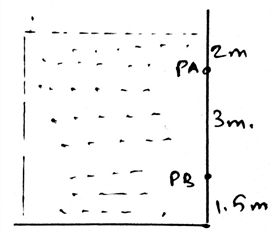Test: Fluid Pressure - Mechanical Engineering MCQ
15 Questions MCQ Test - Test: Fluid Pressure
The Pascal law states that liquid at rest applies pressure at a point is ________ in all directions.
Determine the location of the hydrostatic force acting on the submerged rectangular plate PaPb. Plate has width of 1.5m. Density of water 1000kg/m3.

| 1 Crore+ students have signed up on EduRev. Have you? Download the App |
The magnitude of the pressure of the fluid is not dependent on the _________
The Pascal’s law is applicable to the liquid which is __________________
For the determination of the fluid pressure the body to be experimented is ___________ in the liquid.
What is a collinear system of forces for the system of the fluid liquids?
The system of the collinear and the parallel force for the calculations of the equations in the determination of the fluid pressure are simplified as ________________
What is not the condition for the equilibrium in the determination of the equations of the fluid pressures?
If solving the question in 3D calculations is difficult, then use the 2D system to determine the equations of the fluid pressure.
When the body is in equilibrium beneath the liquid then which of the following is true?
State true or false. We first make equilibrium equations for the fluid pressure and then the free body diagram and then solve the question?
∑Fx=0, ∑Fy=0 and ∑Fz=0 are vector equations for the determination of the equilibrium equations for the fluid pressure in the body immersed in the liquid.
Determine the resultant hydrostatic force acting on the submerged rectangular plate PaPb. Plate has width of 1.5m. Density of water 1000kg/m3.

















